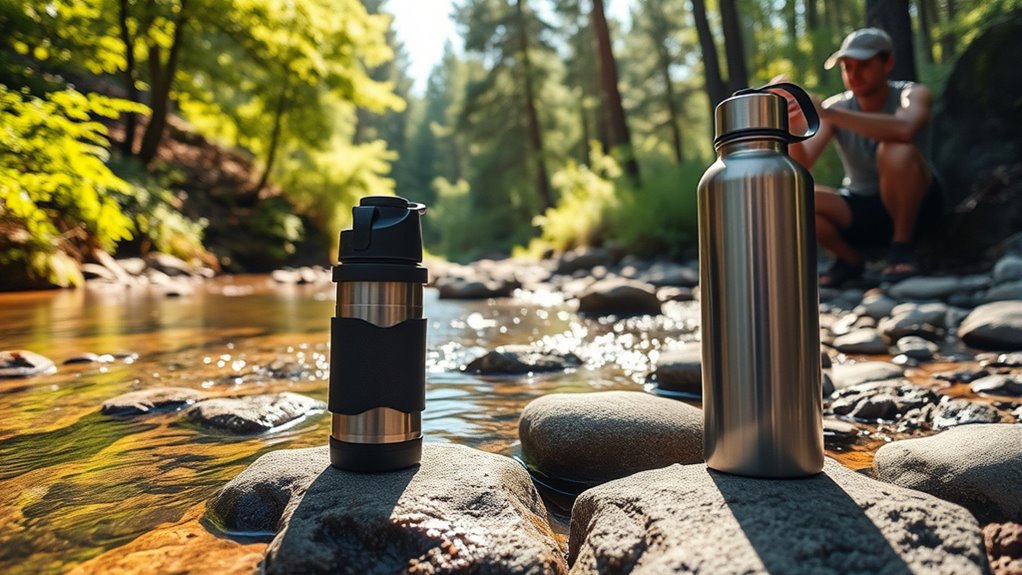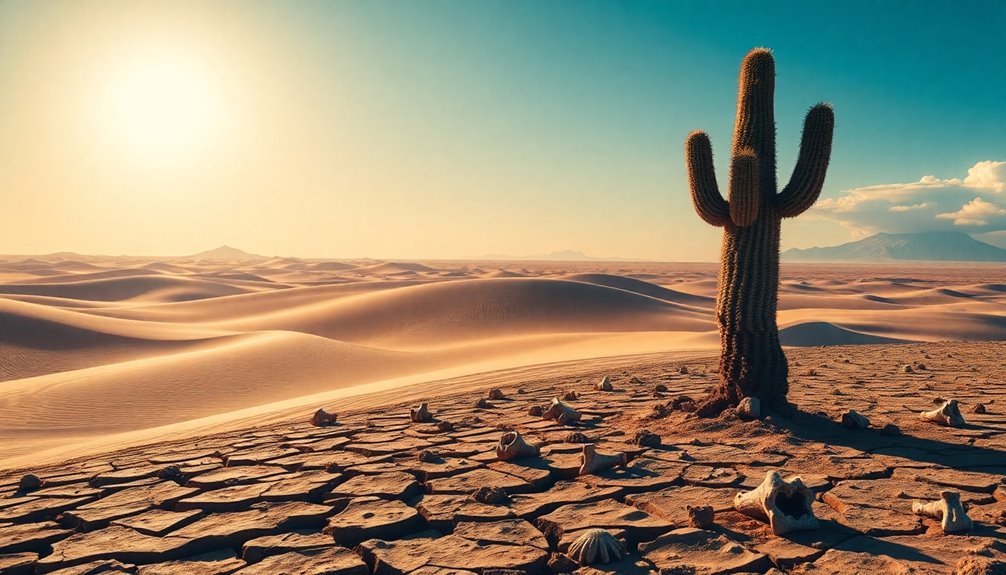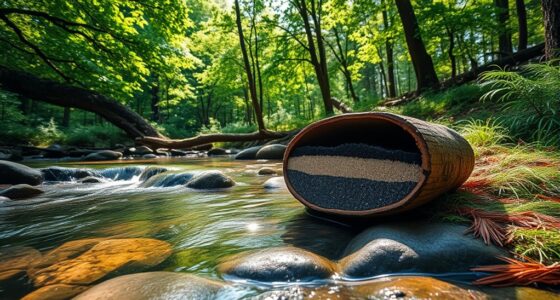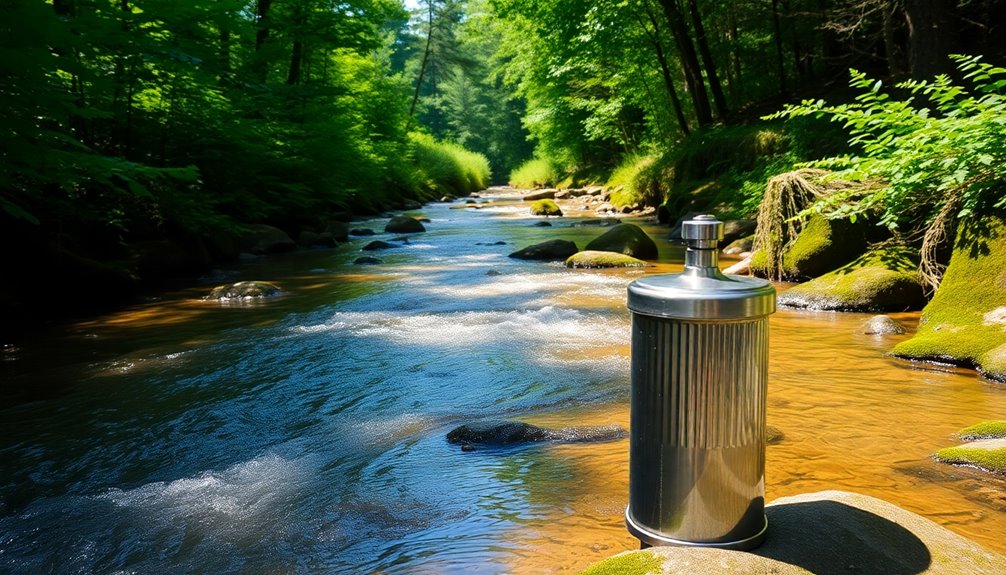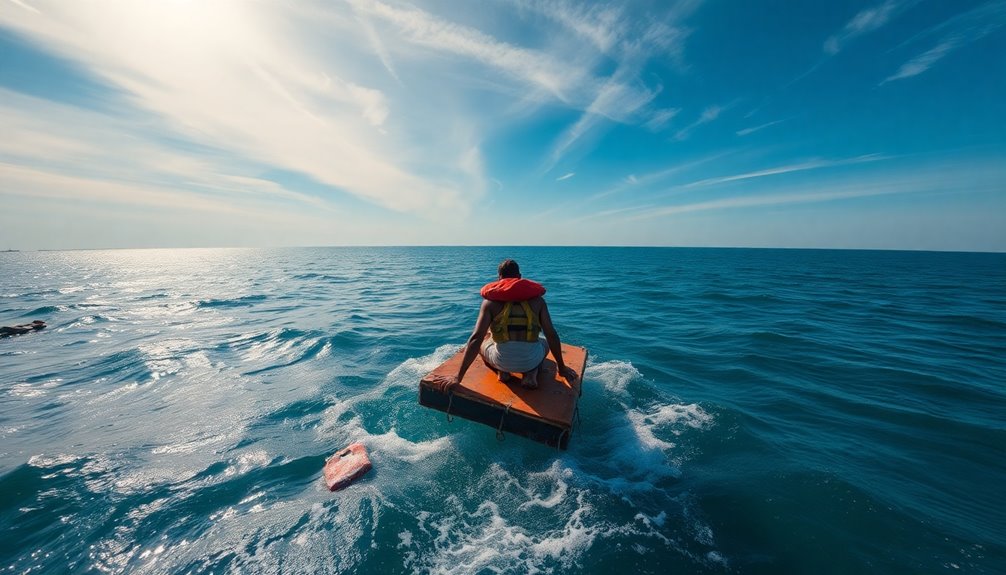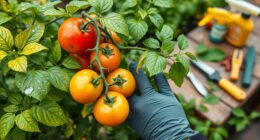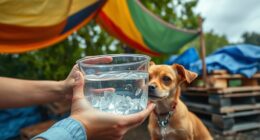When you're out in the wilderness, always prioritize safe water purification. Boiling water for at least one minute kills most harmful microbes, while chemical treatments like bleach and iodine can also help. Mechanical filters can remove larger contaminants, but be sure to pre-filter water to extend their lifespan. Avoid stagnant sources, and combine different purification methods for best results. Stick around to discover more tips on enhancing your water safety!
Key Takeaways
- Always assess water quality; avoid stagnant water that may harbor harmful microorganisms.
- Use boiling as a primary method to kill bacteria, viruses, and parasites effectively.
- Consider chemical treatments like unscented bleach or iodine tablets to enhance purification.
- Employ mechanical filtration with portable filters to remove contaminants, ensuring regular maintenance.
- Pre-filter water to eliminate debris and extend the life of your filtration system.
Understanding Water Contaminants
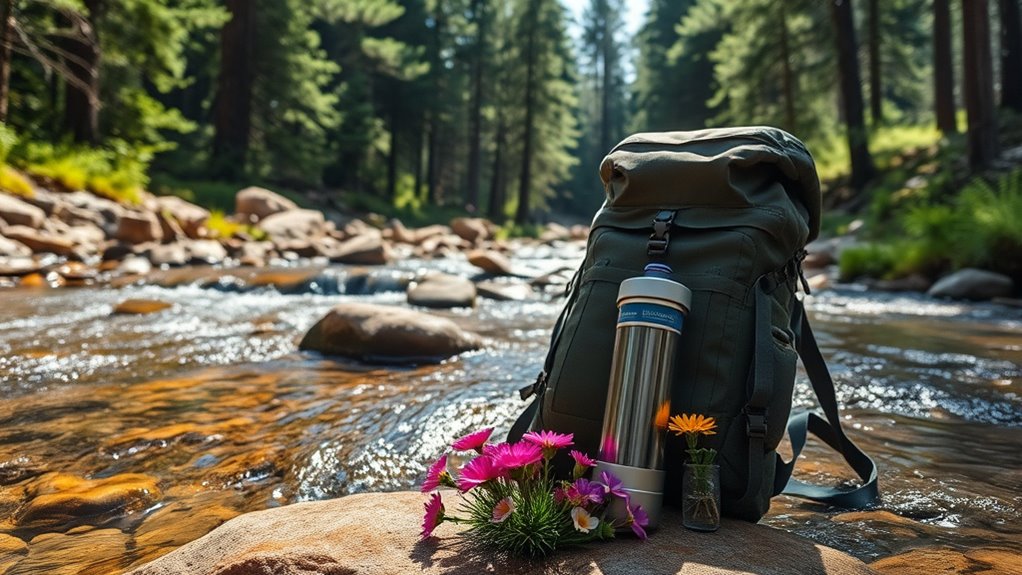
Water contaminants are a serious concern for anyone venturing into the wilderness. You should be aware of common threats, such as bacteria from human and animal waste, which can introduce harmful microbes like *E. coli* and *Salmonella* into your drinking water.
Water contaminants like *E. coli* and *Salmonella* pose serious risks in the wilderness, making awareness essential for safe drinking.
Viruses, smaller than bacteria, also pose significant health risks. Protozoa, like *Giardia* and *Cryptosporidium*, often lurk in water contaminated by animal waste. Additionally, nonprotozoan parasites can cause infections.
Chemical pollutants from industrial and agricultural activities, such as pesticides and heavy metals, further compromise water quality. Understanding these contaminants and their sources, especially human activities and agricultural runoff, is crucial for your safety while exploring the great outdoors.
Stay informed and cautious to protect your health.
The Effectiveness of Boiling Water

When it comes to ensuring safe drinking water in the wilderness, boiling stands out as one of the most effective methods for eliminating harmful pathogens. By bringing water to a rolling boil, you can kill bacteria, viruses, and parasites quickly.
At sea level, boiling for just 1 minute is usually enough, but if you're above 6,562 feet, extend that time to 3 minutes for safety. Keep in mind that boiling won't remove chemical contaminants or improve water clarity, so it's best used alongside other methods like filtration.
While boiling requires a heat source and can be time-consuming, it remains a reliable option when other purification tools aren't available. Plus, you can use boiled water for cooking, adding versatility to your outdoor experience.
Chemical Treatments for Water Purification
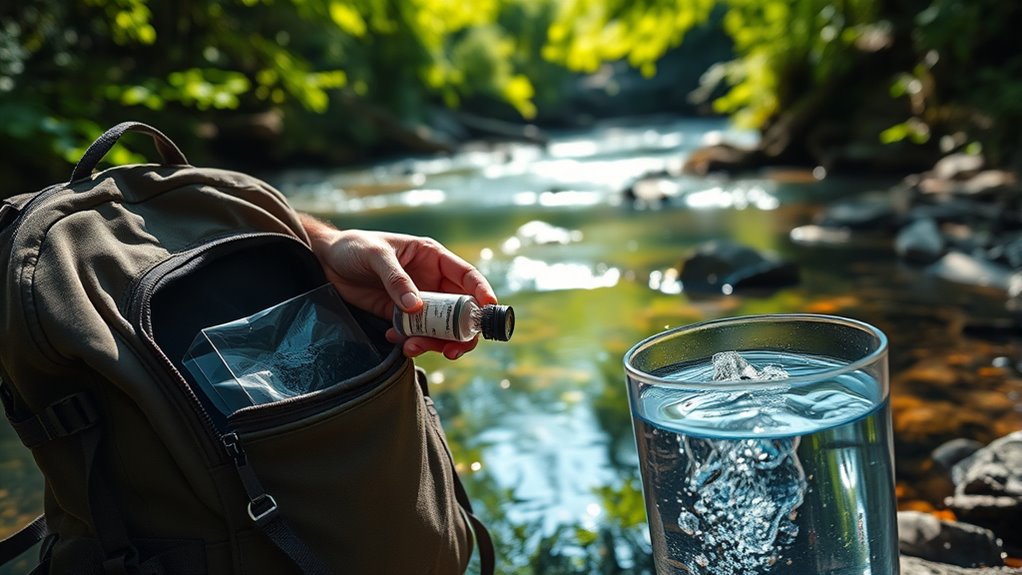
While many outdoor enthusiasts rely on boiling or filtration, chemical treatments offer a practical alternative for purifying water in the wilderness. Common options include unscented household bleach and iodine tablets, both portable and easy to use.
For effective results, follow the manufacturer's dosage guidelines, typically using 5% sodium hypochlorite or iodine. These treatments effectively combat bacteria, viruses, and some protozoa, although they may leave an unpleasant taste and won't remove chemical pollutants.
Always combine chemical methods with other purification techniques, like filtration, for enhanced safety. Store chemicals properly to prevent accidents, and dispose of any waste responsibly to protect the environment.
Exploring Filtration Methods
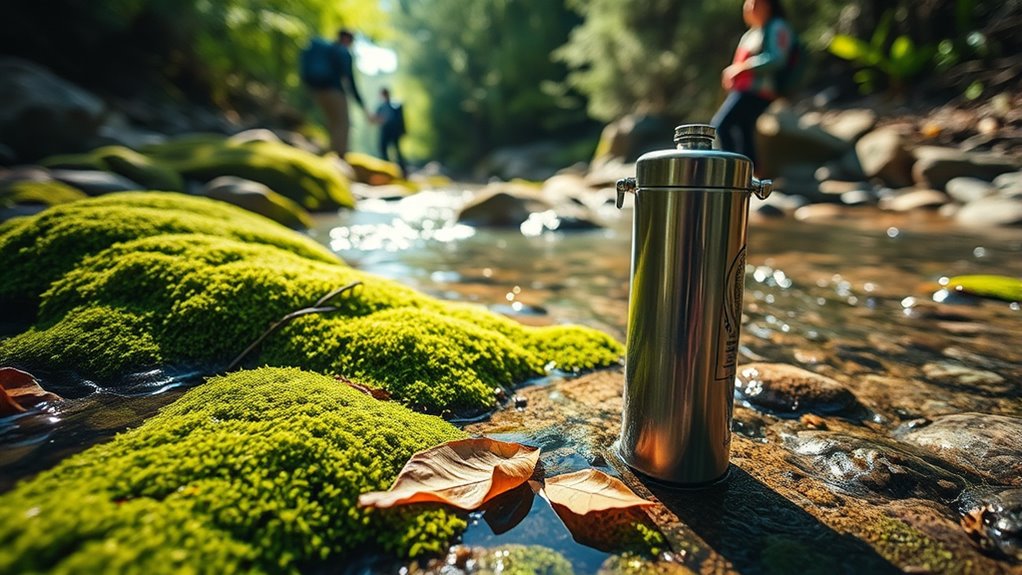
Many outdoor adventurers turn to filtration methods for purifying water, as these systems provide a practical and immediate solution.
Mechanical filtration utilizes physical barriers like sand, rocks, and charcoal to remove contaminants. Common filter types include ceramic, paper, and membrane filters, effective against parasites like Giardia but not viruses.
Portable filters, designed for backpacking, typically have pores of 0.2 microns, removing bacteria and parasites effectively; some even enhance taste with charcoal. However, maintenance is crucial, requiring regular cleaning and filter replacement.
Pre-filtration can extend a filter's life, while clogging can occur with sediment. Always combine filtration with additional purification methods for comprehensive safety, especially in murky water. Additionally, implementing humidity control features can help ensure better overall water quality in various environments.
Primitive and Natural Purification Techniques

Primitive and natural purification techniques offer essential alternatives for outdoor enthusiasts seeking safe drinking water.
Boiling water is one of the simplest methods; just bring it to a rolling boil for at least one minute to kill most pathogens.
Boiling water is a straightforward technique; bring it to a rolling boil for one minute to eliminate most pathogens.
If you're in need of a more advanced method, distillation can help by evaporating water and collecting the clean vapor.
You can also use sedimentation, letting water sit to allow particles to settle, though it won't eliminate pathogens.
For filtration, sand, soil, or activated charcoal can help remove some contaminants.
Additionally, consider using plants like Oregon Grape for their antimicrobial properties, or employ stone boiling when a fire isn't available.
Always choose clean water sources to enhance safety.
Safety Considerations When Purifying Water
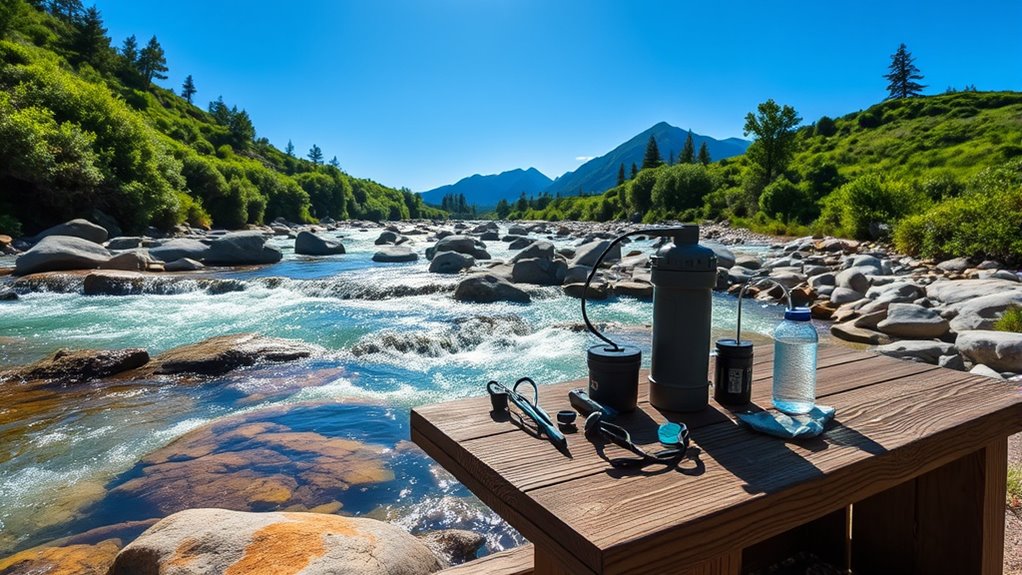
When you're out in the wilderness, ensuring the safety of your water source is as important as the purification methods you choose.
Always assess water quality—just because it looks clean doesn't mean it is. Check for signs of upstream contamination, like dead animals or unhealthy vegetation nearby. Avoid stagnant water, as it's a breeding ground for harmful microorganisms.
Pre-filtering water to remove debris is essential before applying other purification methods. Remember, untreated water can contain dangerous microorganisms, leading to gastrointestinal illnesses and severe health issues.
While boiling, filtration, and chemical disinfection can help, ensure you're using the right method for your situation. Additionally, understanding the importance of emergency preparedness essentials will further enhance your ability to make safe choices in the wilderness.
Prioritize safety to stay healthy and hydrated during your wilderness adventures.
Best Practices for Water Storage
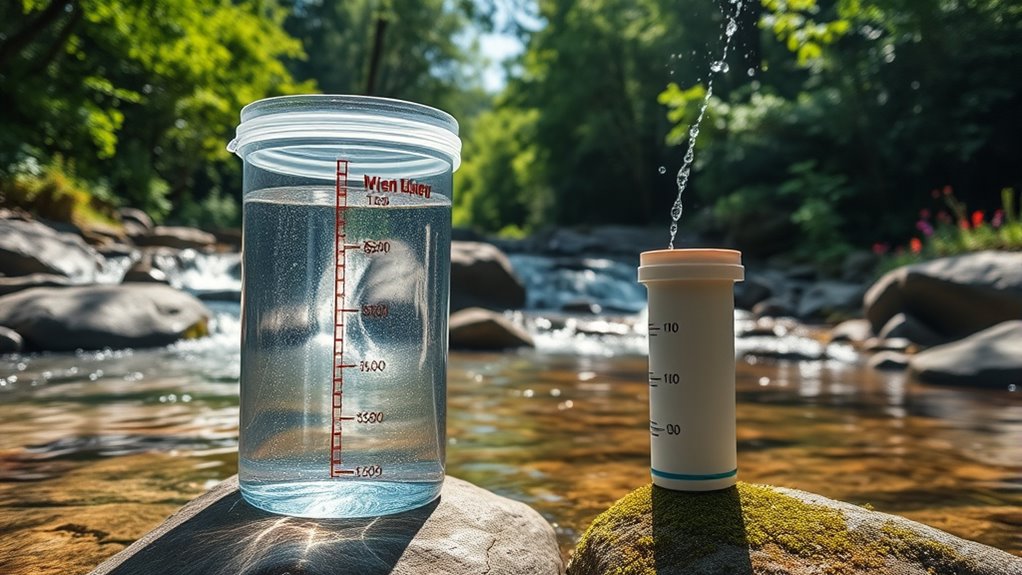
Storing water properly is crucial for ensuring its safety and quality during your wilderness adventures. Use FDA-approved food-grade containers to prevent chemical leaching, and avoid those previously holding non-food items.
Opt for stainless steel to resist corrosion and ensure your containers are sealable to keep out contaminants. Store water in cool, dark places like basements or windowless pantries, maintaining temperatures between 50°F and 70°F.
Clean and sanitize containers before filling them with safe water, and label each one with the date. Rotate your water supply every six months to keep it fresh.
Lastly, make sure some containers are easily accessible for emergencies, and organize your storage for efficient use of space.
Combining Purification Methods for Enhanced Safety
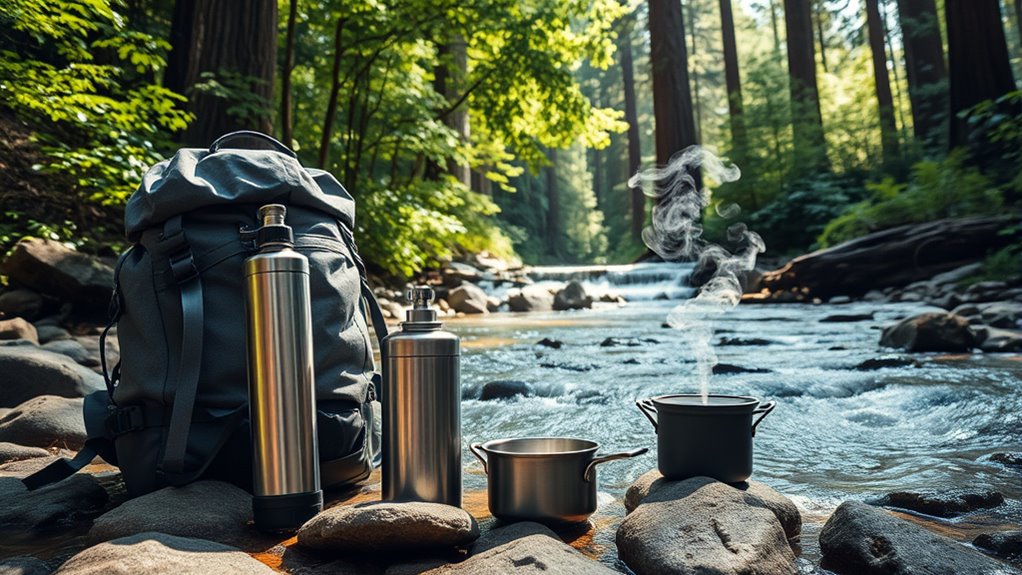
Combining different water purification methods can significantly enhance your safety during wilderness adventures. For instance, pairing boiling with filtration effectively eliminates pathogens and physical contaminants.
If you opt for chemical disinfectants, use them post-filtration to neutralize any remaining small pathogens. Another effective combo is UV light with filtration, which tackles microbiological contaminants and particulate matter.
You can also consider distillation followed by filtration to clear out both chemical and physical impurities. Sedimentation can clarify water before boiling, making the process more efficient.
Always remember to treat water, even if it looks clear, to safeguard against waterborne illnesses. Using multiple methods ensures comprehensive protection from various contaminants, keeping you healthy and safe on your journey.
Frequently Asked Questions
Can I Use Seawater for Drinking After Purification?
You can't drink seawater directly, even after purification, without proper treatment.
While methods like distillation and reverse osmosis can effectively remove salt, they require careful implementation.
Desalinated water might still lack essential minerals, and microbial contamination could be a concern.
If you're considering using seawater for drinking, ensure you have access to reliable purification methods and stay informed about the potential health risks involved in consuming desalinated water.
How Can I Identify a Safe Water Source in the Wild?
When you're out in the wild, finding water's like hunting for treasure—you've gotta know where to look.
Keep an eye out for greenery, animal tracks, and birds; they often lead you to water.
Listen for the sound of flowing streams, which usually indicate cleaner sources.
Look for clear water, and remember, it's best to draw from upstream.
Trust your instincts, and always be cautious about potential contaminants lurking nearby.
Is Rainwater Safe to Drink Without Purification?
Rainwater isn't safe to drink without purification. As it falls, it can pick up contaminants like dust, bacteria, and chemicals.
When collected from roofs or storage systems, additional pollutants like bird droppings might enter the mix. Even if it looks clean, untreated rainwater can harbor harmful pathogens that can make you sick.
To ensure your safety, always purify rainwater using methods like boiling, filtration, or chemical treatments before drinking it.
What Are the Signs of Water Contamination?
To identify signs of water contamination, look for discolored water with unusual colors or excessive floating debris like trash.
Unpleasant odors, especially those resembling sewage or chemicals, are red flags.
You should also be wary of dead fish or wildlife in the area.
If you notice reduced aquatic life or unusual tastes in the water, it's best to avoid drinking it.
Always trust your instincts when something seems off with the water.
Can I Purify Water Using Sunlight?
Yes, you can purify water using sunlight!
The solar disinfection method, or SODIS, involves placing clear plastic bottles filled with water in direct sunlight for at least six hours. This process effectively kills harmful microorganisms.
However, keep in mind that it's most effective on sunny days and requires clear bottles.
For faster results, consider advanced solar technologies that can purify water in just 60 seconds using sunlight-activated powders.
Conclusion
In the wild, water is both a lifeline and a potential danger, much like the delicate balance of nature itself. By mastering purification techniques, you're not just ensuring your survival; you're forging a deeper connection to the world around you. Each drop you safely sip symbolizes resilience and respect for nature's gifts. Embrace these best practices, and you'll navigate the wilderness with confidence, transforming every sip into a celebration of life's purity amidst the chaos.

